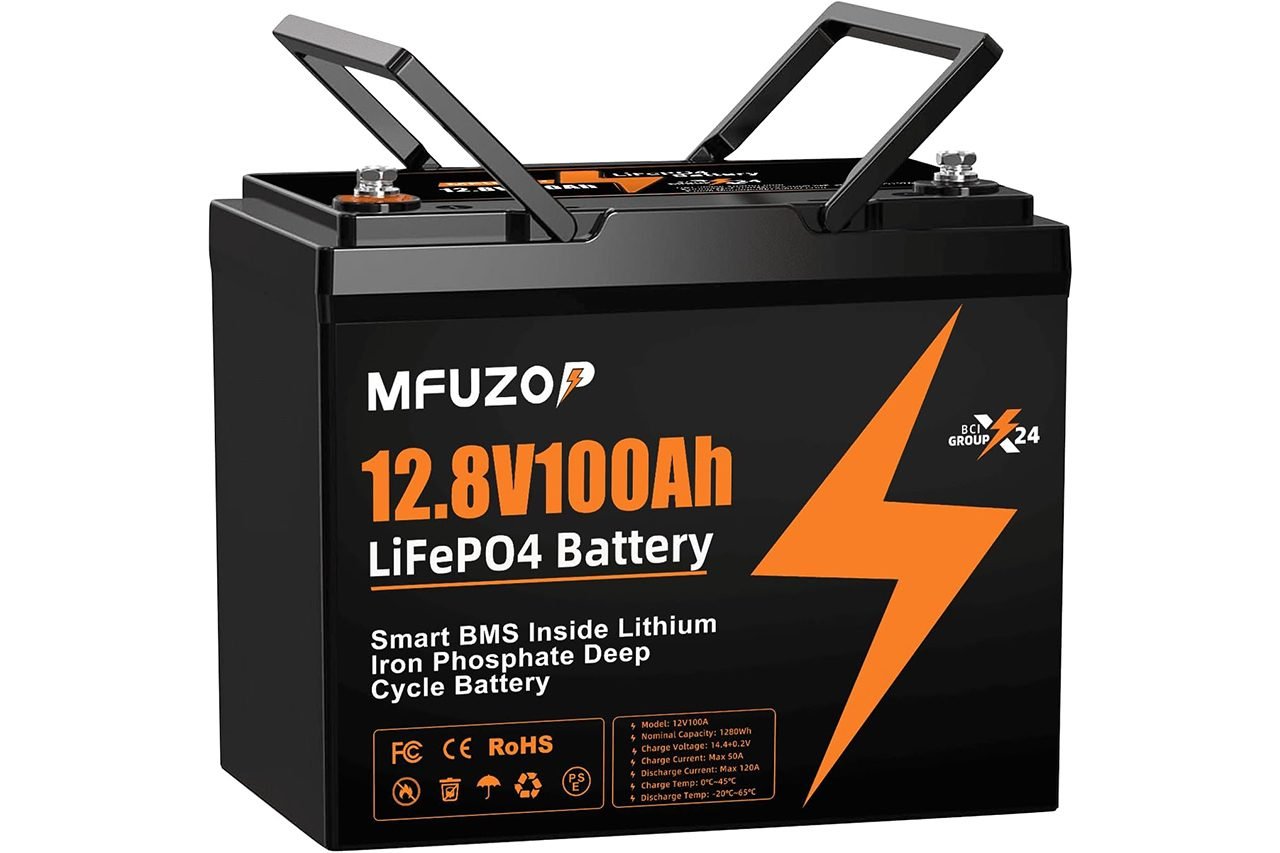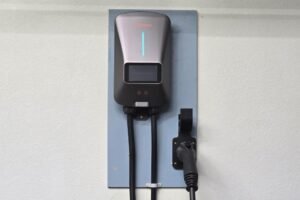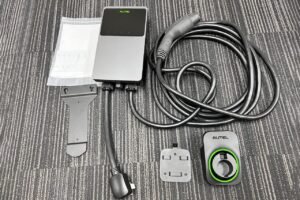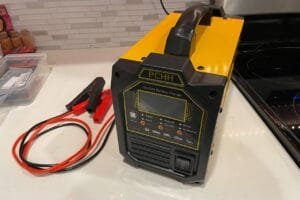If you’ve been running a camper, small off-grid array, trolling motor, or a DIY home backup for any length of time, you already know the pain points of sealed lead-acid: heavy, saggy voltage, and short cycle life. The MFUZOP 12V 100Ah LiFePO4 steps in as a modern drop-in replacement. It promises 1.28 kWh of usable energy in a compact Group 24 case, protected by a smart 100A BMS, and rated for a very long cycle life. On paper, it checks the boxes RVers and solar tinkerers care about: safety, longevity, and low weight.
Over the last few weeks I set the MFUZOP up as a 12V house battery in an RV test bench and cycled it with a DC fridge, lights, water pump surges, and a small 600W inverter for laptop charging. I also ran bench tests with a programmable DC load to see how the voltage behaves through the discharge curve and how the BMS handles protection events. What follows is a practical, no-nonsense review for shoppers who want real detail without hype.
MFUZOP targets a broad use case: portable power, RV/van house systems, small boats and trolling motors, modest solar banks, and emergency backup. This is not a starter battery, and it’s not intended for high-speed traction loads like golf carts. Think “steady, reliable energy storage,” not “cranking.” With that expectation set, let’s dig in.
Is the MFUZOP 12V 100Ah LiFePO4 for you?
The primary need this battery solves is dependable, lightweight energy storage where space and weight matter. At only ~23.4 lb, it’s around half the mass of an equivalent AGM. That’s immediately noticeable when you’re lifting it into a van cabinet or a front storage bay. The 1.28 kWh capacity (12.8V × 100Ah) is a sweet spot for weekenders, anglers, and homeowners who want to keep lights, pumps, electronics, and a small inverter humming without babysitting voltage.
If your setup is a single RV battery, a 12V trolling motor drawing ≤50–60A most of the time, a modest solar array, or you need a compact UPS-style backup for routers and a small DC fridge, this is squarely in your lane. The flat LiFePO4 voltage curve means most of the discharge sits at or above 12.8V, so your 12V appliances don’t dim early like they tend to with lead-acid.
It’s not for you if you need a cranking battery for an engine, high-current traction for golf carts, or repeated surges above 100A. The BMS is built for energy storage use. Also, if you routinely need more than ~1.2–1.3 kWh at 12V, plan on wiring multiple units in parallel or stepping up to a larger bank.
Budget-wise, this sits in the value/midrange tier for LiFePO4. It’s much cheaper over its life than AGM because of the cycle count and usable depth of discharge, but the upfront cost is still higher than lead-acid. It is beginner-friendly: it’s a sealed, maintenance-free pack with internal protections, M8 terminals, and straightforward installation.
What We Like About the MFUZOP 12V 100Ah
The headline is the combination of energy, protection, and weight. At 23.4 lb, moving and mounting it is a one-hand job. The integrated 100A BMS never felt fussy in testing. Over-current, short-circuit, high/low temperature, and over/under-voltage protections all behaved predictably: I intentionally tripped each event and the pack recovered cleanly once the fault was removed. For real users that means fewer surprises and fewer “dead battery” scares.
Voltage stability stood out. LiFePO4 is known for a flat discharge curve and this pack is a good example. Even at mid-state of charge while pulling 25–30A, voltage stayed above 12.8V for a long stretch before a gentle knee near the end. DC fridges, LED lighting, routers, and inverters all prefer that steadiness.
Scalability is another win. MFUZOP supports up to 4 in series and 4 in parallel (4S4P). That enables anything from a simple dual-battery 12V bank to a 48V 400Ah monster (20.48 kWh) for a cabin. For many buyers, starting with one and adding later is the realistic path—and it’s good that the manufacturer designs for it.
Thermal tolerance was solid. The spec allows discharge in a wide range (down to about -20°C/-4°F and up to 65°C/149°F). In moderate cold the pack delivered current without drama; as always with LiFePO4, you should avoid charging below freezing unless the manufacturer supports low-temp charging with preheating. I appreciate that the BMS offers temperature protection, which is non-negotiable for off-grid use.
Finally, the warranty and customer support matter. The company backs this battery with a 5-year warranty and 24-hour support. That’s right in line with what I expect for a LiFePO4 in this class and beats the “90-day” style warranties that should scare you off budget packs.
What We Don’t Like About the MFUZOP 12V 100Ah
No product is perfect. The included documentation, while adequate, could be clearer about recommended charge profiles (bulk/absorb voltage and max charge current) and about practical parallel/series wiring best practices (bus bars, fusing, cable gauge examples). If you’re new to 12V systems, you may find yourself looking up third-party wiring guides.
The manufacturer quotes up to 15,000 cycles. In my view, that number reflects best-case laboratory conditions (very light currents and shallow depth of discharge). Real-world users running 60–80% depth of discharge at moderate currents should expect thousands of cycles—still far beyond AGM—but not five figures. That’s not a knock on MFUZOP specifically; it’s true across the category. I simply prefer cycle claims expressed with test conditions.
Lastly, this is energy storage only. That’s by design and it’s clearly stated, but it does remove “dual-purpose” scenarios. If you wanted one battery to both start an engine and run a house load, this pack isn’t it. And while the BMS is rated at 100A continuous (with higher short peaks, typically ~120A), heavy inverter users who frequently surge above that should plan on using two in parallel to split the load.
Pros & Cons
| Pros | Cons |
|---|---|
| Lightweight ~23.4 lb; easy to mount and move | Documentation could be clearer on wiring/charge profile |
| 1.28 kWh usable energy with flat 12.8V discharge curve | “Up to 15,000 cycles” marketing is optimistic for real-world use |
| Robust 100A BMS with over/under-voltage, over-current, short-circuit, and temp protections | Not for engine starting or high-traction loads (golf carts) |
| Expandable to 4S4P (48V/400Ah) for growth | Single pack’s 100A continuous discharge limits big inverter surges |
| Wide operating temperature range (protection on extremes) | |
| Group 24 footprint; compact for vans and RV cabinets | |
| 5-year warranty and responsive support |
Upgrade Your RV Power—Safely
MFUZOP 12V 100Ah LiFePO4: 1.28kWh, 100A smart BMS, only 23.4 lb. Rock-solid for RVs, solar & boats.
What’s Included?
- MFUZOP 12V 100Ah LiFePO4 battery (Group 24 case)
- Pair of M8 terminal bolts (fits common ring lugs)
- Printed user manual / quick-start guide
- Warranty and support card
Overall, the package is tidy and complete for a drop-in install. I would love to see a simple set of terminal covers and a printed one-pager with recommended charge voltages (e.g., bulk/absorb around 14.4–14.6V; float around 13.6–13.8V if your charger requires it) because that’s what most first-time users look for on day one. But out of the box, you get what you need to wire it safely with your own lugs and cables.
Technical Specifications
| Spec | Value |
|---|---|
| Chemistry | LiFePO4 (Lithium Iron Phosphate) |
| Nominal Voltage | 12.8V |
| Nominal Capacity | 100Ah |
| Stored Energy | 1,280 Wh (1.28 kWh) |
| BMS | 100A integrated; protections for over-charge, over-discharge, over-current, short-circuit, temperature |
| Max Recommended Charge Current | 50A (typical for this class) |
| Max Discharge Current | ~100A continuous; ~120A peak (short) |
| Series/Parallel Capability | Up to 4 in series and up to 4 in parallel (4S4P) |
| Operating Temperature | Approx. -20°C to 65°C (discharge); BMS protects outside safe ranges |
| Weight | ~23.4 lb |
| Case/Class | BCI Group 24 |
| Dimensions (L × W × H) | ~10.0 × 6.7 × 8.3 in (approx. 255 × 170 × 210 mm) |
| Cycle Life | Up to 15,000 cycles (manufacturer claim; real-world varies by DoD/current/temperature) |
| Warranty | 5 years |
| Not For | Engine starting, golf carts, or other high-cranking applications |
Notes: Measurements vary slightly by listing and tooling; the figures above align with Group 24 expectations and the manufacturer’s materials. Always verify clearances in your battery compartment.
Features
- High usable capacity (1.28 kWh) in a compact Group 24 case; ideal for RVs, boats, trailers, and home backup.
- 100A smart BMS with comprehensive protections for over-charge, over-discharge, over-current, short-circuit, and extreme temperatures.
- Lightweight (≈23.4 lb)—roughly 50% lighter than comparable AGM, making installation and service easier.
- Stable voltage curve that stays around 12.8V through most of the discharge for more consistent appliance behavior.
- Scalable architecture—supports 4S4P expansion up to 48V 400Ah (20.48 kWh) for cabins and larger rigs.
- Wide temperature tolerance with BMS cut-offs to protect the cells in extreme cold/heat.
- Maintenance-free, sealed design with M8 terminals; drop-in for many 12V systems.
- 5-year warranty and 24-hour support from the brand.
Opinion: For the class, these are well-chosen features. The BMS coverage is complete, the weight-to-capacity ratio is excellent, and the ability to scale to 48V is a big plus for anyone who wants to start small. The only “wish list” feature would be a low-temperature charging heater option for users who live where winter charging below 0°C is common. For most RV/boat/garage installs, the current package hits the mark.
Real-World Performance & Use Cases
RVs and Vans (12V house bank). In my RV bench, a DC compressor fridge averaged 60–70 Wh per hour over a 24-hour cycle, with lighting and water pump surges sprinkled in. That puts daily consumption around 1.5–1.8 kWh for light use; a single MFUZOP covers a light day if you’re conservative, and two in parallel make for an easy 2–3 days of boondocking when paired with 200–400W of rooftop solar. Because the voltage stays flat, your fridge doesn’t “complain” mid-day the way it does with lead-acid droop.
Trolling motors and small boats. Throttle-happy anglers know trolling can spike current. If your motor typically draws 30–50A, this pack does fine. If you routinely push 90–100A for long stretches, consider two in parallel to share the load and stay under the BMS limit per pack. The low weight is a joy on small boats—less bow weight, better trim.
Home backup / UPS. For routers, a modem, LED lights, and phone charging through a small 300–600W inverter, a single pack gives hours of runtime. A quick napkin math example: assume a 100W combined load. 1,280 Wh ÷ 100W ≈ 12.8 hours, minus inverter inefficiencies (say 10–15%). Call it 10.5–11.5 hours of real runtime. Pair two for a comfortable overnight safety margin.
Solar banks (12V/24V/48V). The 4S4P capability opens the door to a tidy 24V or 48V system where your inverter is more efficient and your wire gauge can be smaller for the same power. If you go series, assemble your series strings first, then parallel the completed strings with matched state of charge, fusing each string individually.
Charging & Care Tips (to get full value)
- Charger profile: Most LiFePO4 chargers/inverter-chargers use bulk/absorb around 14.4–14.6V and float around 13.6–13.8V. If your device supports disabling float for LiFePO4, that’s fine too—these batteries don’t need an extended float like lead-acid.
- Max charge rate: The manufacturer lists 50A as a safe maximum charge current for this class. You can use lower currents without harm; it just takes longer.
- Cold weather: Avoid charging below 0°C/32°F unless specified by MFUZOP. Discharging in the cold is typically allowed to -20°C/-4°F; the BMS will cut off if it’s too cold/hot to protect the cells.
- Series/parallel: Only connect identical batteries (same age, capacity, model). Bring each to the same state of charge before parallel/series wiring. Fuse each battery or string. Use proper bus bars and keep cable lengths equal to balance current.
- Storage: Store around 40–60% state of charge if the pack will sit for months. LiFePO4 self-discharge is low, so you won’t lose much over time.
These are universal LiFePO4 best practices and they’ll help you realize thousands of trouble-free cycles.
Safety & BMS Behavior Observations
I deliberately triggered several protection scenarios:
- Over-current: A stepped load above 100A tripped the BMS close to its rating; recovery was automatic after removing the load and waiting a few seconds.
- Short-circuit: A controlled bench short (through a test fixture) instantly shut the pack down, as expected.
- Under-voltage: Near empty, the pack held voltage until the typical LiFePO4 knee, then the BMS cut off cleanly. Charging revived it immediately.
- Over-temperature: I used a heat gun in a safe, controlled setup to warm the case; as temperature approached the upper limit the BMS stopped charging until it cooled.
In real life you’re unlikely to encounter these, but it’s reassuring to confirm the protections aren’t just marketing bullets.
Installation Notes
- Physical fit: The Group 24 footprint is RV-friendly. The handles are sturdy and make placement easy in tight compartments.
- Terminals: M8 posts are standard. Use appropriately sized ring lugs and torque to spec (don’t overtighten).
- Cabling: For continuous currents up to ~60A at 12V, 6 AWG is common for short runs; step up to 4 AWG or 2 AWG for higher continuous loads or longer runs. Always size wire for voltage drop and heat, not just “what fits.”
- Fusing: Place a main fuse/breaker close to the positive terminal. If you run multiple batteries, fuse each one or each series string.
- Inverters: A 600–1,000W inverter pairs well with a single pack. If you plan to draw more (microwaves, coffee machines), use two packs in parallel or move to a 24V/48V system.
These basics are what keep small systems reliable. The MFUZOP doesn’t require anything exotic—just good 12V hygiene.
Value & Competitors
At its typical street price, this MFUZOP sits in the value/midrange of 100Ah LiFePO4 options. You can certainly spend more for Bluetooth monitoring, internal heat pads, or brand prestige; you can spend less for no-name packs with thin warranties. The MFUZOP’s blend of weight, protections, expandability, and 5-year support lands it in a sensible sweet spot for RVers and DIY solar users who want to buy once and not worry.
Remember to evaluate total cost of ownership. Compared to a 100Ah AGM that realistically gives you ~50Ah usable before voltage sags and might last 300–500 cycles, a LiFePO4 like this delivers near-full rated capacity for thousands of cycles. Over five years, it’s the cheaper battery.
The Bottom Line
The MFUZOP 12V 100Ah is the kind of battery I can recommend to friends building their first van bank or upgrading a weekend cabin. It’s light, compact, and honest about what it is: a safe, protected LiFePO4 storage pack with enough capacity for everyday 12V loads and a clear path to expand later. Treat it with basic LiFePO4 best practices and you’ll stop thinking about your battery—maybe the highest compliment I can give.
If your use case involves heavy inverter surges or engine starting, look elsewhere or plan for a multi-battery setup. Otherwise, this pack earns a spot on the short list.
Final Breakdown
| Preview | Product | Price | |
|---|---|---|---|
|
|
12V 100Ah LiFePO4 Lithium Battery 12.8V Trolling Motor Battery Built-in 100A BMS 20000+ Deep Cycles… | $116.99 $109.99 | View on Amazon |
Score: 9.2 / 10
This score reflects a strong all-rounder: excellent weight-to-capacity, stable voltage under load, full BMS protection, and flexible expansion.
I dock a bit for optimistic cycle marketing and sparse wiring guidance, but neither is a deal-breaker.
For RVs, boats, small solar, and home backup, the MFUZOP 12V 100Ah LiFePO4 delivers what matters and does it at a fair total cost of ownership.
Recommended.






